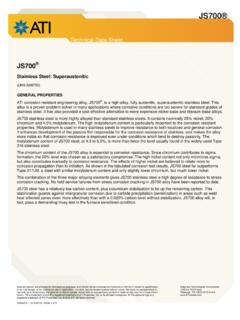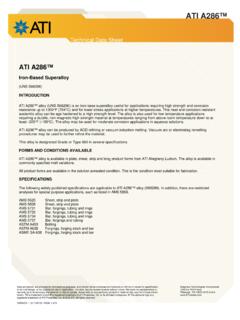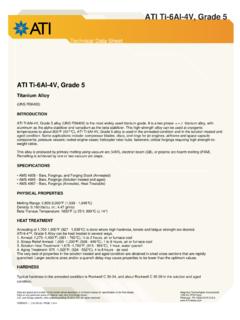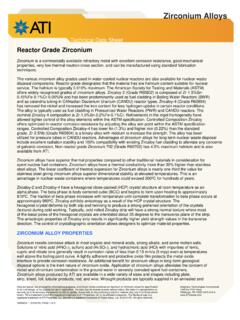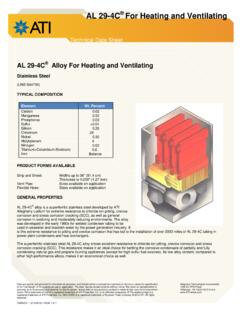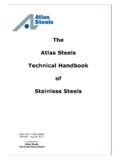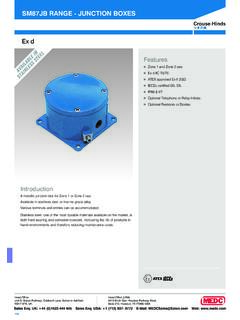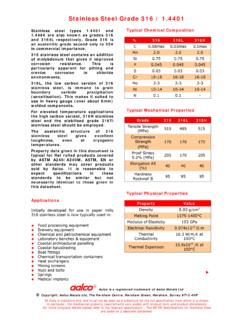Transcription of EUROPE MIDDLE EAST AL 29-4C Alloy - atimetals.com
1 AL 29-4C AlloyA Superferritic stainless steel forPower Plant and DesalinationCondenser TubingStarburst logo is a registered trademark of ATI Properties, Inc. 2013 ATI 11/13 MISSION CRITICAL MATERIALSTMASIA/ AUSTRALIAA ustralia Office4A Anglesey AvenueSt. George, SA, 5064 AustraliaPhone: 61-488-991-886 China, Beijing OfficeRoom 805 Scitech Tower, No. 22 Jianguomenwai AvenueBeijing 100004, ChinaPhone: 86-10-65120451 China, Shanghai OfficeRoom 21 E, Huadu Mansion, 838 Zhangyang RoadPudong, Shanghai ChinaPhone: 86-21-5081-5268/6278/6598 India501, Montreal Business Center,Tower No.
2 1 Pallod Farm, Baner Road,Pune 411 045, IndiaPhone: 91-20-2729-0251 JapanMinami-Aoyama M-Square 5F2-2-3 Minami-Aoyama, Minato-ku,Tokyo 107-0062, JapanPhone: 81-3-5770-3880 Korea14th Floor, Yulchon Bldg. 24-1 Yoido-Dong, Youngdeungpo-ku,Seoul, 150-877, KoreaPhone: 82-2-761-3961-5 Singapore31 Ubi Road 1 #05-01 Lobby BAztech Building Sinagapore 408594 Phone: 65-6883-2577 Taiwan5F., , , , Zhongli City,Taoyuan County 32046 TaiwanPhone: 886-3-401-4031 EUROPEF ranceCAP Mermoz 38 rue Jean Mermoz78600 Maisons LaffittePhone: 33-1-34-93-80-20 GermanyHeltorfer Strasse 1 aD-40472, D esseldorf, GermanyPhone: 49-211-513-560-0 Great BritainCyclops Works, President WaySheffield, S4 7 URPhone: 44-114-272-0081 Israel & Turkey142 Kedem Street, PO Box 1751 Shoham 73142 IsraelPhone: 972-3-979-5135 Spainc/San Bartolme, 3-5 Leioa Vizcaya, SpainPhone: 34-944-0104-55 ScandinaviaVassbonnyn 2601411 Kolbotn, NorwayPhone: 47-917-86-149 ItalyVia dell Ontano nr.
3 3-2920090 Rodano (MI), ltaliaPhone: 39-02-95-320-663 MIDDLE EASTD ubaiPO Box 263090 Dubai Arab EmiratesPhone: 971-4-884-9318 CENTRAL & SOUTH AMERICAC entral & South AmericaRua Coronel Abilio Soares261 6 andarCj 62 Centro Santo Andr SP Brasil CEP 09020260 Phone: +55-11-9-8750-0434 ATI Allegheny Ludlum1300 Pacific AvenueNatrona Heights, PA 15065 :+ ALLEGHENY LUDLUM INTERNATIONAL SALES OFFICESG eneral PropertiesAL 29-4C Alloy , is a superferritic stainless steel developed by ATI Allegheny Ludlum in the early 1980s specifically for power plant surface condenser tubing. Since that time over 60 million feet of superferritic condenser tube has been put into service.
4 The Alloy has excellent resistance to brackish, polluted or high chloride waters, , seawater, when properly manufactured by the tube producer. While maintaining all attributes of convention-al ferritic stainless steels, AL 29-4C Alloy provides the following advantages over other competitive materials: 1. High resistance to severe chloride environments, such as seawater 2. Better resistance to vibration damage than titanium 3. Better resistance to erosion-corrosion than titanium and copper base alloys 4. Better heat transfer properties than austenitic stainless steels 5. Low cobalt content 6. Cost DevelopmentHistorically, the major disadvantage in using conventional stain-less steels in seawater and other aggressive waters has been the susceptibility of these steels to chloride pitting and crevice corro-sion.
5 Conventional stainless steels are particularly susceptible to corrosion if deposits form or low flow conditions exist in high chloride resistance to chloride pitting and crevice corrosioncorrelates with increased chromium and molybdenum content in stainless steels. The basic composition of AL 29-4C Alloy (29% chromium and 4% molybdenum) was derived from the work of M. A. Streicher (Corrosion 30 (3), 1974, pp. 77-91). Streicher used two laboratory tests to establish the chromium and molyb-denum content necessary for optimum resistance to chloride crevice and pitting corrosion. One test utilized a 2% KMnO4 2% NaCl solution at 195 F (90 C) while the second test utilized a 10% FeCl3 solution at 122 F (50 C).
6 The FeCl3 test was conducted in a manner similar to ASTM pro-cedure G48B and used teflon blocks held with rubber bands to create crevice conditions. Streicher s results are shown schemat-ically in Figure effect of chromium and molybdenum is synergistic, , less molybdenum is needed at higher chromium levels. For example, alloys have 26% chromium and 3% molybdenum exhibitedpitting or crevice attack in the two corrosion tests while alloys containing 27-30% chromium and molybdenum were resistant in both tests. High levels of molybdenum ( , 5%) were found to decrease both ductility and stress corrosion cracking resistance (in 42% boiling magnesium chloride).
7 These limits have come to define the family of superferritic stainless steels S44735 and S44660 known as AL 29-4C and SEA-CURE , respectively. The only other deliberate alloying additions to AL 29-4C Alloy are titanium and niobium as stabilizing elements. The stabilizers are added to combine with carbon and nitrogen to improve weldabili-ty, toughness and resistance to integranular 1 Effect of Chromium and Molybdenum on the Properties of Fe-Cr-Mo CompositionTable 1 Element Weight Percent Chromium 29 Molybdenum 4 Nickel Manganese Phosphorus Sulfur Silicon Cobalt Carbon Nitrogen Titanium + Niobium Data shown are typical.
8 And should not be construed as maximum or minimumvalues for specification or for final design. Data on any particular piece of material may vary from those shown herein. SEA-CURE is a registered trademark of Plymouth Tube CompanyAL 29-4C The severity of the ferric chloride test can be increased byincreasing the test temperature or acidifying the 3 compares the typical performance of AL 29-4C tubingto that of titanium tubing ( grade 2) at room temperature, 95 F (35 C) and 122 F (50 C). The excellent resistance of AL 29-4 Ctubing is 3 Crevice Corrosion Test in 10% Ferric Chloride for 72 Hours. AL 29-4C Ti-CP grade 270 F (21 C)95 F (35 C)122 F (50 C)Figure 4 Test Panels with Artificial Crevices after 9 Months of Exposure to 316L26Cr-3Mo-3 NiAL 29-4C Seawater TestingAL 29-4C Alloy has also been tested in a seawater immersion test.
9 The test was conducted in quiescent seawater for a 9-monthperiod. The average water conditions were: 53 F ( C), 30,900 ppm salinity, pH and dissolved oxygen ppm. Figure 4 compares the performance of Type 316L, a 26% chromium, 3% molybdenum and 3% nickel Alloy , with AL 29-4C Alloy after nine months of immersion. Artificial crevices were imposed prior to immersion on welded, annealed and scale free samples. The AL 29-4C samples showed no evidence of corrosion; however both the Type 316L and the 26% chromium-3% molybde-num-3% nickel Alloy suffered crevice corrosion. The seawater immersion results clearly show the superior performance of AL 29-4C Alloy .
10 Corrosion ResistancePitting & Crevice Corrosion ResistanceThe most important corrosion property to consider whenevaluating stainless steels for service in aggressive waters is resistance to chloride crevice corrosion. AL 29-4C Alloy is extremely resistant to chloride crevice corrosion, after welding, annealing and post weld cleaning of oxide discoloration. This is typically done by acid pickling or bright annealing (preferably in a reducing atmosphere) for the highest level of corrosion resistance to warm 2 compares the performance of AL 29-4C Alloy with the conventional Type 316L stainless steel in the ASTM G48 10%ferric chloride test at room temperature for different test times.
